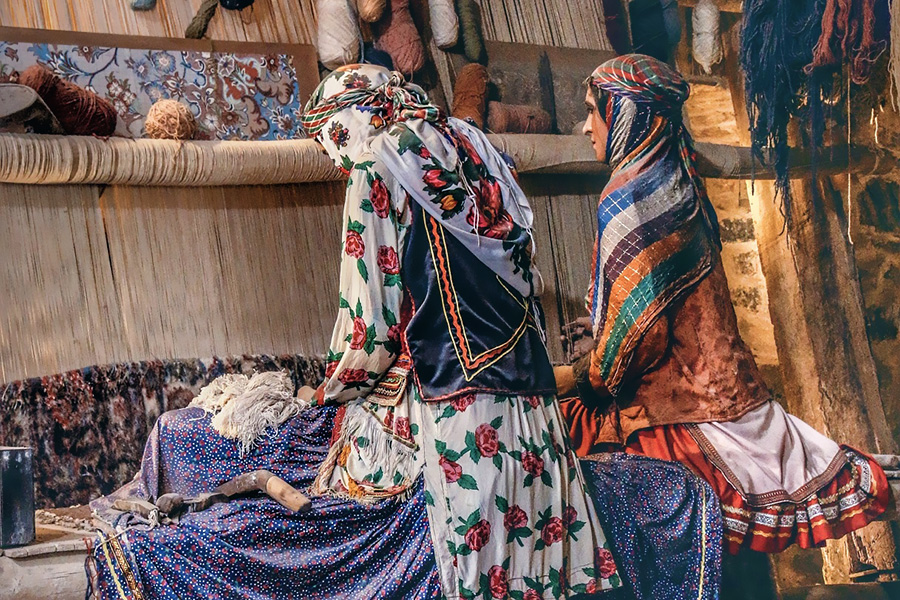The Role of Women in Preserving Iranian Cultural Heritage
Preserving cultural heritage is essential for any society, acting as a link between past and present while shaping future identities. In Iran, women play a vital role in this process by actively participating in various cultural practices that protect traditional arts, crafts, and customs. Their efforts not only help maintain the richness of Iranian culture but also have a significant economic impact, illustrating the connection between cultural preservation and economic development.

By: Salma Ngongondo
Preserving cultural heritage is essential for any society, acting as a link between past and present while shaping future identities. In Iran, women play a vital role in this process by actively participating in various cultural practices that protect traditional arts, crafts, and customs. Their efforts not only help maintain the richness of Iranian culture but also have a significant economic impact, illustrating the connection between cultural preservation and economic development.
Historically, women in Iran have been the guardians of cultural traditions, often serving as the primary transmitters of knowledge and skills within their families and communities. This is especially evident in traditional crafts such as carpet weaving, pottery, and embroidery. For example, the craft of Persian carpet weaving is a deeply ingrained tradition, with many women taking the lead in this art form. In cities like Kashan and Isfahan, women create exquisite carpets known for their intricate designs and craftsmanship, which are celebrated globally. By producing these beautiful textiles, women not only help preserve an important cultural practice but also create valuable products sought after both inside and outside Iran. The international demand for Iranian carpets offers significant economic opportunities, enabling women artisans to support their families while ensuring that these traditional techniques endure.
In addition to crafts, women are key contributors to Iran’s culinary heritage, which is an essential part of cultural identity. Traditional Iranian cuisine, known for its diverse flavors and regional specialties, is predominantly taught and practiced by women in their homes. For instance, in northern Iran, women prepare dishes like Mirza Ghasemi, a smoked eggplant dish, and Zereshk Polo, a saffron rice dish with barberries, reflecting local ingredients and culinary traditions. The increasing global interest in Persian cuisine has opened avenues for women to engage in food-related enterprises, such as catering and cooking classes. Notably, chefs like Parvin Javid have gained international acclaim for their culinary expertise, promoting Persian cuisine on the world stage and enhancing Iran’s cultural profile.
Furthermore, women in Iran are pivotal in preserving folklore and oral traditions. Storytelling, music, and dance are rich cultural expressions that often rely on women’s participation. In rural regions like Kurdistan, women gather to share traditional stories and perform songs and dances during community celebrations. These gatherings not only strengthen community bonds but also ensure that traditional narratives and practices are upheld. Female performers, particularly in the Ghazal genre, enrich the cultural landscape by highlighting regional stories and musical styles, thereby contributing to tourism, which is a significant sector of Iran’s economy.
The Iranian government has acknowledged the importance of women in cultural preservation, implementing programs to empower female artisans and promote their work. Organizations such as the Iranian Cultural Heritage, Handicrafts and Tourism Organization (ICHHTO) have initiated projects to support women artisans by providing training, resources, and platforms for their success. Workshops are often organized to teach traditional crafts to younger women, ensuring that these skills are passed down through generations. Events like the annual Tehran International Handicrafts Exhibition provide essential platforms for women artisans to showcase their creations, gaining recognition for their contributions to Iranian culture.
Additionally, women’s participation in cultural festivals and exhibitions has greatly enhanced their roles as cultural ambassadors. Events such as the Iran International Women’s Film Festival highlight the talents of female filmmakers and artists, showcasing their unique perspectives and contributions to Iranian cinema and culture. These platforms not only celebrate women’s achievements but also inspire future generations to connect with their cultural heritage.
In summary, women are crucial to the preservation of Iranian cultural heritage, acting as guardians of traditions that shape the nation’s identity. Through their active involvement in traditional crafts, culinary practices, and oral storytelling, women not only protect these cultural expressions but also make significant contributions to the economy. Their achievements emphasize the important link between cultural preservation and economic development, highlighting the need to support and empower women in their roles as cultural stewards. As Iran continues to confront the challenges of modernity and globalization, the contributions of women will be essential in ensuring that the nation’s rich cultural heritage is preserved for future generations.

Write your comment.